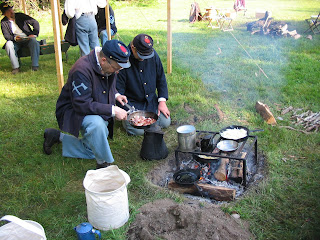
Memorial Day. Pembroke Ma. Center Cemetery. Saluting our veterans.
I was recently contacted by a customer seeking a stove for use in his Civil War Re-enactment work. He kindly provided me with a great education in this "sport". But rather than try and paraphrase, I'll let Rob tell you himself...
"We are the 22nd Mass. Infantry. If you look at the coming events you will see the events we will be attending.
"I love re-enacting. It's a major step back in time. Especially at night. When all of the campfires are lit and the tents and streets are lit up by candles. I can't wait. Right now we cook over an open fire. The trick is to get your food somewhere between cold and burnt. Or just have it fall in the fire. That's why I'm looking for a small stove.
"We have a bunch civilian re-enactors. Every now and then some of these women dress in blue and join us in the field. (at Battles) They dress the kids up it's a good time.
"There is a village that is called 'Serenity' or something like that. They are all civilians. They are at all of the weekend re-enactments. If you are interested I will get you this information.
"Be prepared though! We do camp and live just like it is 1864. Obviously there are coolers but they are covered up. All cooking is done over an open fire. It is primitive camping. Some find a hotel near by and come for the day and sleep a hole lot better than we do. Although I am getting used to this. You can use cots to sleep on. Some of the really professional civilians actually bring beds.
"It's great to walk around and see the different setups. I'm purchasing a cot for this year.
"We are a great family orientated, professional group. We really do a great job when we talk to the public. We have a couple of families that come from out in your direction (Goshen, MA)."





Borderland State Park, Ma.

Forbes Museum Milton Ma. The big guy in the middle is me, Rob

Lincoln Day, Old Ship Church, Hingham Ma.

Sunrise on the civilian Camp. Groton, Ma.

Our youngest recruit. Groton, Ma.

Groton, Ma. Sunrise on the Union Camp

Group of civilians that I met at Cedar Creek, Va.
Breakfast




